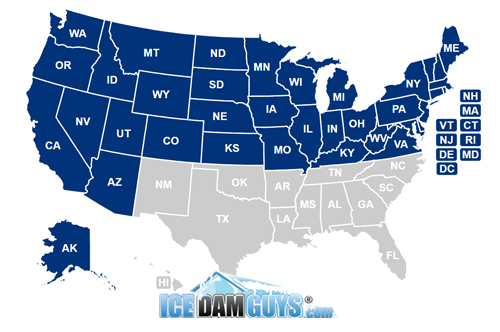How Much Does Roof Snow Weigh?
Call us at 1-800-ICE-DAMS if you have an ice dam on your roof and live anywhere in the US, including in hard-hit Alaska. We are properly licensed, bonded, and insured, and are the top-rated ice dam removal company in the US. You can end the leaks with a phone call to Ice Dam Guys®.
To some, snow on the roof is a charming winter scene that reminds you of gingerbread houses at Christmas. It may look nice, until it’s a nightmare.
Snow on your roof can become enough of hazard that it can bring the entire structure crashing down. That’s not a concern limited to rickety old homes. Any roof can collapse. Even the roof on the Metrodome collapsed, and it was built specifically with a snowy & cold climate in mind.
It’s important to know how much snow is just too much snow, and when to get it removed. To know that, you need to know how much snow weighs.
Between my nearly 20 years of experience as an ice dam removal professional, and some research and number-crunching, I’ve got some answers (which I’ll get to in a minute).
Some parts of this article are faster reading than others. I wanted to share my “lab notes” if you’re interested. In case not, I’ve also tried to make this skimmable.
How much the snow on your roof weighs depends on many factors. There is no one hard number. Even stating how much any given cubic foot of snow weighs is actually harder than it looks.
Factor: The shape of snow.
No two snowflakes are alike. Every snowflake is a tiny, crystalline ice structure. A snowflake falls when a tiny droplet of water falls at a high altitude. As it falls to Earth, additional moisture attaches to the already-frozen droplet, creating little branches. By the time that snowflake reaches your roof, hundreds of these branches have formed, creating a really complex structure. That structure determines how the snow will pack when it piles up on your roof.
Fortunately, you don’t have to get a microscope to evaluate the structure. You can make some generalizations. You either get light, fluffy snow, or you get that thick, heavy, watery snow.

Figure 1. Defined branches (light, fluffy snow).

Figure 2. Less defined branches (heavy, wet snow).
(Images are courtesy of Don Moore of the National Weather Service)
You can also predict how this is going to go, a little bit, by noting the temperature when the snow starts to fall. Counterintuitively, colder weather is less hazardous to your roof. For example, 10-degree weather tends to produce light, fluffy snow. Conversely, 31-degree weather will produce wet, heavy snow. The closer it is to freezing (32 degrees), the more potentially dangerous to your roof the snow becomes.
Incidentally, the same higher temperature ranges are likely to create the ideal conditions for ice dams as well. Ice dams can form long before you’re likely to face a roof collapse. Therefore, if you know you have a home that is prone to ice dams, you’ll want to be on your snow-removal game and rake your roof after every six inches or so of accumulation.
Key points:
- No two snowflakes are alike, which makes it hard to make generalizations about snow weight.
- Snowflakes with well-defined branches are lighter, fluffier, and less dangerous.
- Colder weather produces lighter snow. The closer temperatures are to freezing, the wetter, heavier, and more dangerous snow becomes.
- The same temperature conditions that create heavy snow also create the ideal weather conditions for ice dams.
- If your home is prone to ice dams, rake your roof after every six inches of snow accumulation.
Factors: Weight and water content.
Of course, none of this discussion on snowflake shape and snow type tells us much about the actual weight of snow. For that, we have to dig in and crunch some numbers.
First, let’s establish a few facts and get our bearings straight.
First, snow is just frozen water, so measuring the weight of one cubic foot of water is a good start, even though snow holds different amounts of water, depending on its shape. One cubic foot of water weighs approximately 62.4 pounds. That’s the size of a box measuring one foot, by one foot, by one foot
But one cubic foot of snow will weigh less than that, and the amount it weighs will depend on how much water is actually contained in the snow. The actual water content of snow commonly ranges from 5% to 32%. 20% is about average for a Midwestern snowfall. This means the snow weighs 20% of what pure water would weigh. That means the same volume of snow only weighs 12.48 pounds per cubic foot. If the saturation reaches 32%, by the way, you’re looking at 19.92 pounds per cubic foot.
Most of us don’t measure snow in terms of feet, so let’s break this down into inches. If you divide 12.48 (what one cubic foot of average snow weighs) by 12, that equals 1.04. That means 1’’ of average snow accumulation weighs 1.04 pounds per square foot.
All that math brings me to a rule of thumb I’ve used for years. It’s one that simplifies matters, because there’s really no easy way to measure the water content of the snow on your roof – not without going through a bunch of crazy, possibly dangerous, time-consuming shenanigans nobody in their right mind wants to go through. I’ve seen snow geeks talk about cutting a cubic foot of snow off the roof, taking it inside to melt it down, and measuring the results. That’s madness. For one thing, it means getting up on your wet, icy, slick, slippery roof in the dead of winter, attempting to cut an exact cubic foot of snow and attempting to haul it all down to conduct what amounts to a useless, time-devouring experiment.
So here’s my educated, math-informed rule of thumb:
1 inch of snowfall on the roof weighs approximately one pound per square foot.
We’ve already established the water content of snow can range anywhere from 5% to 32%, which would mean 1” of snow ranges from .26 pounds per square foot (“PSF”) to 1.66 PSF. To find the average weight of the snow, add those numbers and divide by 2. We get an average of .96 lbs., which is mighty close to 1 pound. (However, you might note right away that especially wet or heavy snow can easily be closer to 2 pounds PSF—note the conditions outside, and use your common sense).
From that, you’ve got a handy formula you can use to determine approximately how many pounds of snow are on your roof: just multiply the inches of snow that have fallen by the square footage of your roof. That number is approximately the number of pounds of snow on your roof.
So, for example, if you got three inches of snowfall and you have an average-sized 2000-square-foot roof, your roof is holding 6000 pounds of snow. That’s like melting two stripped-down SUVs (each weighing 3470 pounds) into a slab of steel and laying that slab on your roof.
That number can be even more dramatic, depending on a few factors.
If the snow on your roof is extremely wet and heavy, you can multiply the “inches of snow times square footage of roof” sum by 1.66 to get a worst-case scenario figure. (In the above example, that comes out to 9960 pounds.)
For an average-size roof (about 2000 square feet) covered in heavy wet snow, a good rule of thumb is the weight of one compact SUV (3,470 lbs.) on your roof for every 1-inch of snow.
It is also important to remember that that math doesn’t take into account any ice you have on your roof, which weighs much more than heavy wet snow weighs.
Key points:
- The water content of any given cubic foot of snow can strongly influence how much the snow actually weighs.
- 1 cubic foot of water weighs 62.4 lbs. One cubic foot of snow usually weighs 5% to 32% of that. In the Midwest, the water content of a cubic foot of snow averages about 20%, or 12.48 pounds. By the way, none of our scenarios takes into account the weight of snow after it has soaked up falling rain. Rain can easily double the weight of already heavy/wet snow.
- 1 cubic foot of ice weighs 57.2 lbs, which is more than five times the weight of even the wettest, heaviest snow. None of our scenarios takes into account the presence and/or weight of ice , which is almost always accompanies snow
- The average roof in the U.S. measures about 2000 square feet.
- The average compact SUV weighs about 3470 lbs.
- A rule of thumb – regarding the weight of average snow: One inch of snow, on average, weighs 1 lb. per square foot. That knowledge is what tells you that mere 1.75 inches of average-weight snow on a typical roof is the equivalent of one compact SUV parked on the roof.
- A rule of thumb regarding the weight of light, fluffy snow: One inch of snow weighs 0.26 pounds per square foot. That means for every 6.5 inches of snowfall you’ve got the weight of a compact SUV on your roof.
- A rule of thumb regarding the weight of heavy, wet snow: One inch of snow weighs 1.66 pounds per square foot. That means that for every single inch of heavy, wet snow on an average-sized roof, you’ve got the equivalent of one compact SUV parked up there.
How much weight can the average roof support? How much snow can it take?
Determining your roof’s capacity to handle snow is even more complicated, because weight is not the only factor influencing how much your roof can handle.
For instance, what condition is your roof in? An older roof with rotted supports (you may not know about yet) can take much less snow than a new, fully functional, well-maintained roof.
The pitch of the roof makes a big difference, too. A steep roof does a much better job of handling snow than a flat roof does. The roof-pitch affects weight distribution, allowing it to hold a little more snowpack safely. In addition, the slope of the roof helps to dump some of that snow back on the ground, removing more stress. The wind also blows the snow more easily off of a steeper-pitched roof.
A flat roof, by contrast, is in danger of collapsing much faster. Most roof collapses happen on flat roofs because all of that weight just sits there (i.e. dead weight with no disbursement or displacement whatsoever). When you get just a few inches of snow on a flat roof, it quickly becomes the equivalent of parking a car or two up there. Not good.
The year your house was built also matters. If your house was constructed after 1971 (in Minnesota for instance) it would have been held to long-standing building codes that require roofing to support 40 pounds per square foot. If your house was built in the 1920s, however, your roofing can probably withstand only 30 pounds per square foot.
Even all those roofing factors are not the only factors that determine the likelihood of a collapse. The weather matters, too.
Wind is a factor. Snow doesn’t fall in a nice, neat, even carpet to begin with. Snow drifts. More wind means more drifts. You might have had 8 inches of snow last night, but that doesn’t mean there are 8 inches of snow spread evenly over your roof, like frosting on a cake. Some parts of your roof won’t have much snow at all, and some parts may have a two foot or even a four-foot drift. That’s putting a lot of pressure on one concentrated area of your roof. Again, not good.
If all of this is making you scratch your head as you attempt to account for every single factor on the list, you could always use the figures provided by the Institute for Business and Home Safety (IBHS), which offers rough numbers based on the type of snow. Note that they ignore the rest of the factors, which can influence whether a roof collapses, but their guidelines remain useful nonetheless:
Fresh snow: 10-12 inches of new snow is equal to about one inch of water, or about 5 pounds per square foot of roof space, so you could have up to 4 ft. of new snow before the roof will become stressed.
Packed snow: 3-5 inches of old snow is equal to one inch of water, or about 5 lbs. per square foot of roof space, so anything more than 2 feet of snow could be too much for your roof to handle.
Total accumulated weight: Two feet of old snow and two feet of new snow could weigh as much as 60 lbs. per square foot of roof space, which is beyond the typical snow load capacity of most roofs.
Ice: One inch of ice equals one foot of fresh snow.
If you want to simplify all of this even more, and play it really safe, you can take my advice – as a guy who has dealt with snow and ice on rooftops for nearly 20 years:
Remove the snow at 2 feet if you have a newer, pitched roof that is in decent shape, and if the weather has not made it heavier than normal. Check for larger drifts. Since most of these contributing factors increase the weight and danger of the snow you can’t really go wrong by playing it safe. In addition, two feet is also about the most your average roof rake is going to be able to handle; wait much longer than that and you might well have to call in a professional roof snow removal service, especially if that snow happens to ice over and harden while you put off having to remove it.
Obviously, if you have an older roof, live in a manufactured home, have a business with a flat roof, or have a flat porch roof on your home, then you’ll want to be even more conservative. In those cases, I recommend using 12 inches of snow as your line in the sand for snow removal.
What if you lose track of how much snow is up there, or you don’t have a good vantage point to guesstimate from the ground? (After all, you’re busy. You’re not watching every weather report and you probably won’t go up there with a ladder and ruler.)
If that happens, go around your home opening the doors and the windows. If any of them gives you trouble, that could mean that the snow has compressed your roof, in turn putting pressure on the door and window frames. If that’s happened, you have far too much snow for your roof to bear and you need to get the snow removed STAT.
Key points:
- Older roofs or roofs in bad shape may not be able to withstand as much snow as some published guidelines might suggest.
- Flat roofs typically hold the least amount of weight, depending on their construction.
- Excessive rainfall or a constant thaw-and-freeze cycle can quickly increase the weight of the roof snow to dangerous levels. Get more conservative about snow removal if you see these conditions.
- Your best bet is to treat 2 feet of snow as the maximum snow load a healthy, modern, sloped roof can take, and to be vigilant about watching for snow drifts that might be deeper and more dangerous.
- If you have an older roof, live in a manufactured home, or have a property with a flat roof, then it pays to be even more conservative: use 12 inches as your hard limit for snow removal.
- If you find it difficult to open any of your doors or windows this is a sign the snow load has grown too heavy for your house to bear. Seek the help of an ice and snow removal service immediately. You may even consider spending a night or two in a motel. Roof collapses are very real, and they can often times lead to tragedy. Give them the serious attention they deserve.
What is the best way to remove snow from the roof?
Always stand on the ground. Never work from a ladder. Use a roof rake with rollers or a plastic edge to pull the snow off of your roof. Make sure you use an extendable pole so you’re able to stand far enough away from the edge of your roof that you’re not standing directly in the line of fire as the snow comes crashing down from your roof. The last thing you want to do is part your hair with a block of ice
Never, ever get up on your roof. Professionals will get up there with shovels and steamers, but you’re paying us to do that, and we’re trained & insured against accidents. You don’t need or want to risk injury, death, or disability by standing on a slick ladder or a slippery roof in the dead of winter.
If you don’t feel confident that you can get the job done without hurting yourself, get a professional. Don’t injure yourself just to save a few bucks.
Want to learn more about the weight of snow?
No problem. I’ve got some resources for you.
- How Much Does Snow Weigh? (The Weather Channel). This video has some great visuals to help you picture the weight of the snow. It also talks about the kind of damage snow can do when it falls off your roof.
- IBHS Urges Home and Business Owners to Reduce Risk of Winter-Related Damage Now. This article covers a number of winter risks, and includes links that will help you explore those topics in-depth. Roof collapses are #2 on the list.
- What is Snow Water Equivalent? This article is from the United States Department of Agriculture. It discusses a common snowpack measurement. It also talks about how meteorologists decide how many “inches” of snow have fallen.
- How Much Snow Is Too Much for Your Roof?. From Popular Mechanics. They do a great job of diagramming the roof for you, helping you to understand exactly how a roof resists a snow load. It also offers some general guidelines for when you ought to remove the snow.
Remember, a roof collapse could cause severe injury (or worse) to you or your loved ones, to say nothing of the thousands upon thousands of dollars in repair costs, increased homeowner’s insurance premiums, and other major hassles. At the end of the day, it’s important not to get too hung up on waiting until you’ve got the absolute maximum amount of snow up there. If you think you might need to remove that snow, it’s probably a good idea to do so.






















